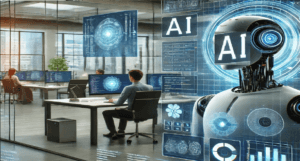AI at Work: The Jobs It Can Do – And Those It Shouldn’t
Generative AI is reshaping industries by automating tasks, but its implementation should consider ethical and practical factors beyond capability. Task complexity affects automation feasibility, as jobs requiring advanced reasoning are harder to replace. High-frequency tasks are more suited for AI, while fragmentation costs can make automation inefficient. The cost of failure is crucial, as AI mistakes in critical fields like medicine or aviation can have severe consequences. Students can explore discussion questions on AI’s impact and research a fast-growing career using BLS data. This involves analyzing job roles, growth factors, and AI’s potential benefits and risks. The activity encourages critical thinking on AI’s role in the workforce and its broader implications.

AI at Work: The Jobs It Can Do – And Those It Shouldn’t
Generative AI is transforming industries by automating specific tasks and, in some cases, replacing human workers. However, determining whether AI should be integrated into a job goes beyond assessing its capabilities—it requires a careful evaluation of ethical, economic, and operational factors. The article presents four critical considerations that help define AI’s appropriate role in the workplace.
The first factor is task complexity. Jobs that involve advanced reasoning, problem-solving, and nuanced decision-making are more difficult to automate. AI excels at handling structured data and repetitive processes but struggles with tasks that require critical thinking, empathy, or adaptability. For example, a customer service chatbot can address common inquiries, but an emergency dispatcher needs to evaluate high-pressure situations and make life-or-death decisions. This distinction underscores why automation must be evaluated based on the depth of human judgment required.
The second key factor is task frequency. AI is particularly effective at managing high-volume, repetitive tasks where maintaining consistency is crucial. Tasks performed frequently, such as data entry, inventory tracking, or automated quality control in manufacturing, are prime candidates for AI automation. Since AI does not suffer from fatigue or errors caused by repetitive work, businesses often find significant efficiency gains in automating these tasks. However, while frequent tasks are easier to automate, decision-makers must still weigh whether AI adoption aligns with long-term organizational goals.
Another major consideration is fragmentation costs, which arise when tasks require multiple steps and frequent human intervention. In many industries, work is interconnected, meaning that automating one segment of a process may lead to inefficiencies in the overall workflow. If AI is used for customer triage in a call center, but a human representative still needs to step in for resolution, information gaps may emerge, causing delays or miscommunication. This fragmentation can be particularly problematic in fields like healthcare, where AI might process patient data but human doctors must ensure accurate diagnoses and treatments. High fragmentation costs can reduce the effectiveness of automation, making a fully AI-driven system impractical.
The fourth crucial factor is the cost of failure. Mistakes made by AI can have vastly different consequences depending on the industry. In fields like medicine, aviation, or law enforcement, even a minor error can have severe repercussions, including legal liabilities, financial losses, or threats to human life. While AI-powered diagnostic tools can assist doctors, they must not replace medical professionals who can interpret complex cases and make ethical decisions. Similarly, AI-driven autopilot systems enhance flight safety, but human pilots remain essential for handling unexpected challenges. In high-risk fields, the need for human oversight is paramount to mitigate potential AI failures.
To deepen their understanding, students can engage in discussion questions that assess AI’s suitability for different roles. These include examining why ethical considerations are crucial in AI adoption, how task complexity influences AI’s effectiveness, and the risks of automating high-frequency tasks. Students can also explore the consequences of AI errors in various industries, analyze AI’s impact on programming jobs, and assess the significance of human-AI collaboration in maintaining work quality.
Additionally, students are encouraged to research a rapidly growing profession using data from the U.S. Bureau of Labor Statistics (BLS). This exercise involves summarizing the role, work environment, and key responsibilities of the job while identifying factors contributing to its rapid growth. For example, technological advancements, demographic shifts, and economic changes can all drive employment trends. By applying the four AI assessment criteria, students can evaluate whether AI could assist in performing certain tasks within the chosen profession and what potential risks automation might introduce.
By participating in these discussions and research activities, students develop a critical perspective on AI’s evolving role in the workforce. They gain insights into how AI can enhance productivity and efficiency while also recognizing its limitations and potential drawbacks. This balanced understanding helps them navigate the complexities of AI-driven job transformation and its broader implications for the economy and society. Ultimately, the responsible use of AI in the workplace requires thoughtful decision-making that prioritizes both technological advancements and human expertise.
Check out TimesWordle.com for all the latest news
You must be logged in to post a comment.